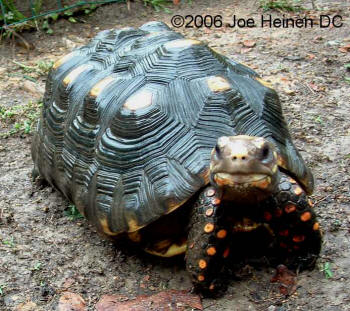Pyramiding in Tortoises
Pyramiding is a form of metabolic bone disease (MBD). It is characterized by a build up or stacking of keratin in the scutes. In advanced cases the shell becomes soft and flattens out. The above tortoise was rescued from horrible conditions. When I received it the plastron was so soft I could push it in with light pressure. If you were to tap on the pyramids, they sounded hollow. After a summer of grazing on grasses and weeds with plenty of sun and exercise, its shell is now rock hard.
I have discussed this extensively with veterinarians that specialize in reptiles, reptile rehabbers and experienced keepers. It appears that pyramiding in tortoises is from a number of causes. Some are fairly obvious and are mentioned on just about every web site that deals with chelonians:
- too much protein
- too little calcium
- too much phosphorous (a poor calcium :phosphorous ratio)
- not enough D3
However there are some less obvious, though equally important factors involved
- lack of exercise
- hydration status
- grain based diets
- lack of fiber
- too much food
Traditionally the focus has been on protein and calcium. But the protein issue is not as simple as limiting high protein foods. A tortoise can be fed too much protein by feeding large quantities of low protein food. They can also get too much by being fed a normal amount of "good" food if they are confined in a small pen with limited exercise. In the wild tortoises typically walk miles while foraging. The more exercise they get, the more protein is needed. Excess protein in the diet causes the shell to put down heavy layers of keratin. This results in conical scutes giving rise to the appearance of pyramids. It also puts an extra burden on the kidneys and other organs.
Calcium is also an important factor. In the wild the main sources are from the plants, the soil and in the water. Phosphorous plays a limiting role in calcium utilization. High levels of phosphorous leads to calcium being leached from the bones. A recent study showed that teenage girls are now showing signs of early osteoporosis. The relate it to drinking soda which are high in phosphoric acid. For our tortoises the main dietary source of phosphorous is protein. So once again high protein diets tie in. To counter act this and to get the calcium/phosphorous ratio to a healthy 2:1 , its is often recommended to dust all food with calcium (usually calcium carbonate). While superficially it does seem to have benefit, it has its own problems. Too much calcium results in secondary deficiencies of zinc, copper and iodine, malabsorption of essential fatty acids, and formation of calcium-containing bladder stones. Lack of calcium results in soft shells that often accompany pyramiding.
Vitamin D3 is essential for proper calcium utilization. Tortoises produce their own from exposure to ultraviolet B rays . The ideal source is from exposure to the sun. However many calcium supplements come with D3. Its very easy to over supplement with D3. This can result in calcification of soft tissue. There are a number of bulbs available that provide UVB so D3 supplementation isn't necessary. For more info on the output of these bulbs visit http://carolinapetsupplu.com/uvb.htm
An often overlooked factor is grain based diets. These are the pellet food that some claim to be essential to health. They typically contain soy, wheat and or rice. These are high in omega 6 fatty acids which has a negative effect on health. They also have an acidifying effect which causes a leaching of bone. They are high in phytates which binds calcium and other minerals. They also have an unfavorable ca/ph ratio and a low ca/mg ratio which has a negative impact on calcium metabolism. Grains alter Vit D metabolism. Diets high in grains can have a negative impact on bone growth in spite of adequate exposure to sunshine. (http://www.heinenchiropracticcenter.com//nutrition/Diet/Cereal%20article-1.pdf)
Exercise is very important. It speeds up metabolism. As mentioned before it increases the need for protein. It also causes healthy deposition of calcium in the bones.
Fiber is extremely important for tortoises (as is the type of fiber):
"The cells of the lower bowel receive about 50% of their nutrition from the nutrients in ingesta (and 50% from the blood stream). They specifically need beta-hydroxybutyrate (a short-chain fatty acid that derives from the fermentation of fiber in the lower bowel). One can compare fermentation rates between pellets and the fiber lengths we use, and see a significant difference. The differences means that tortoises on our foods have healthier bowels, which translates into better stools, better abilities to resist and control parasite infestations, better energy metabolism, and better control of nitrogen metabolism (and hence kidney health). Moreover, more water is held in the lower bowel when they're fed the longer length forages, which helps again with water balance and hence kidney function."
Susan Donoghue, VMD, DACVN
Hydration is also important. It includes not just having enough water for drinking but humidity as well. A recent study showed that Sulcata kept at higher humidity levels resulted in less pyramiding than those kept in more arid conditions....in spite of a high protein diet. (diet paper)


